Configuring and Creating Questionnaire Event
PeopleSoft Questionnaire Events enables you to provide questionnaires outside of an activity guide through email or online notifications. This feature works with the existing Questionnaire Framework, which is used to create the questionnaire.
These topics discuss configuring and creating questionnaire events using the Questionnaire Framework.
Note: Oracle PeopleSoft delivers Notification Composer Framework to manage the setup and administration of all notifications in one central location. Once you have adopted the Notification Composer feature, you must use it to create new notifications and manage your existing notifications. For more information about Notification Composer, see Understanding Notification Composer.
|
Page Name |
Definition Name |
Usage |
|---|---|---|
|
EOQF_RECIPIENT_FL |
Add or edit a recipient list for questionnaire events. |
|
|
EOQF_SUBST_FL |
Create text placeholders for questionnaire event notifications. |
|
|
EOQF_NOTIF_FL |
Add or edit notification message text for questionnaire events. |
|
|
EOQN_TECH_CONFIG |
Configure setup data for use in creating questionnaire events that trigger questionnaires from application pages. |
|
|
EOQN_MAP_CFG_SEC |
View or update the generated event mapping for the portal registry. |
|
|
EOQF_EVENT_ADMN_FL |
View, update, add, delete, and copy questionnaire events. |
|
|
EOQF_EVENT_ADD_SCF |
Create a new questionnaire event and define basic event information. |
|
|
EOQF_EVENT_CNFG_FL |
Specify questionnaire event details and recipients. |
|
|
EOQF_EVENT_NOTF_FL |
Associate one or more notifications with the questionnaire event. |
|
|
EOQF_NOTF_DSGN_SCF |
Create a notification for the questionnaire event. |
|
|
EOQF_EVENT_PRCS_FL |
Activate or Deactivate the Questionnaire Event. |
|
|
EOQF_EVNT_STAT_SCF |
View data related to the questionnaire event, such as response status and processing history. |
|
|
EOQF_CLONE_EVN_SCF |
Copy an existing questionnaire event. |
|
|
EOQF_EVENT_RUNCNTL |
Run an adhoc notification process for a specific questionnaire event. |
A questionnaire event allows you to share questionnaires with recipients outside of an activity guide, using email and push (in-app) notifications.
The Questionnaire Event feature enables you to:
Define parameters for the event, such as start date and frequency of the event.
Associate a questionnaire with the event.
Specify recipients and associate them with the event.
Define notifications and associate them with the event.
Initiate an adhoc notification process for an event.
View statistical data for the event.
PeopleSoft supports these types of questionnaire events:
Single
Use this event type to send questionnaires using notifications for one-time activities, for example, send surveys to employees to provide feedback on training programs they completed.
Continuous
Use this event type to send questionnaires using notifications for ongoing activities, for example, send surveys to new hires to share feedback a month after onboarding the company.
Application Generated
Use this event type to trigger questionnaires in real time and notify users when application pages are saved, for example, send questionnaires to request additional information when users submit HR HelpDesk cases in Employee Self-Service.
Application Generated questionnaire events send out notifications immediately when transactions are saved and the triggering conditions in the event configuration are met. It is different from Single and Continuous event types, which send out questionnaire notifications using a scheduled batch process.
Note: The Application Generated event type is supported in FSCM as of Update Image 53.
Here are the high-level steps for setting up data for use when creating questionnaire events:
Define recipient lists on the Recipient List Page. When creating a questionnaire event, you need to specify a list of recipients to whom the questionnaires and notifications are sent.
If Notification Composer is enabled, define user lists in the Notification Composer Framework instead.
If the selected questionnaire event type is Application Generated, recipients are specified on the Configurable Trigger Page.
Define text placeholders that can be used in notification templates on the Text Placeholder Definition Page.
(For Application Generated event type only) Enable fields for use as additional text placeholders and in defining conditions for triggering questionnaires, specify recipients, and map trigger configuration to application pages on the Configurable Trigger Page.
Create text templates for use when composing notification texts on the Notification Template Page.
If Notification Composer is enabled, define text templates in the Notification Composer Framework using the Questionnaire Framework notification category instead.
See Also Creating and Managing Notifications with Notification Composer.
For information about the roles and permission lists delivered for the Questionnaire Framework, refer to the Understanding Security in Questionnaire Framework topic.
Follow these steps to create questionnaire events in an activity guide process:
Create a questionnaire event using the Create Questionnaire Event Page.
Specify event details using the Define Event Configuration Page.
Associate notifications with the event using the Define Notification Settings Page.
Activate the questionnaire event using the Process Questionnaire Event Page.
Sending Questionnaire Event Notifications
After event activation, set up a schedule to run the EOQF_PROCESS job (for example, nightly) in the system. It selects all active questionnaire events and sends out corresponding notifications when the scheduled dates of the notifications match the current date.
Note: This scheduling task is applicable to questionnaire events of Single and Continuous types only.
Use the Recipient List page (EOQF_RECIPIENT_FL) to add or edit a recipient list for questionnaire events.
Navigation:
This example illustrates the Recipient List page.
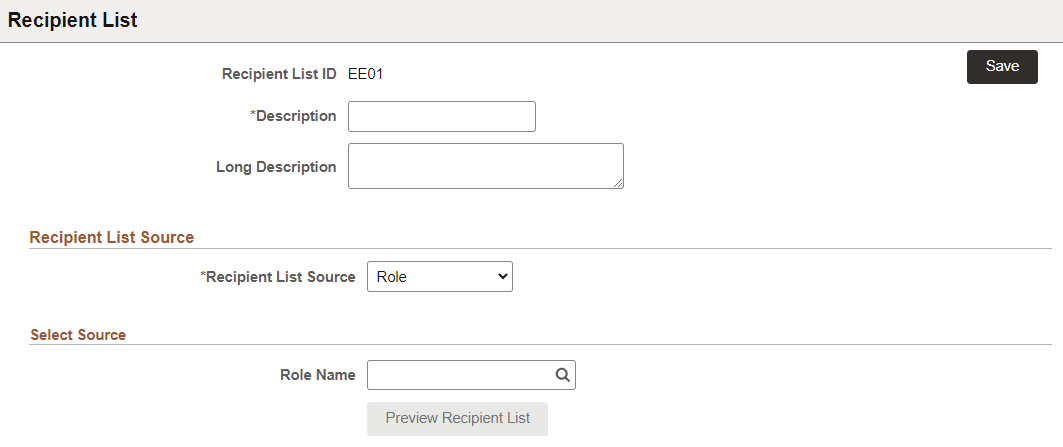
Note: Use this page to define recipient lists for Single and Continuous event types when Notification Composer is not enabled. Recipient lists for the Application Generated event type are defined on the Configurable Trigger Page.
|
Field or Control |
Description |
|---|---|
|
Recipient List ID |
Displays the recipient list ID you entered prior to accessing this page. |
|
Description and Long Description |
Enter a meaningful short and long description for the recipient list. |
|
Recipient List Source |
Select a source for the recipient list. Available values are:
|
|
Root Package ID |
Select the Root package associated with the PeopleTools Application Class that acts as the source for the recipient list. This field appears only when Application Class is selected as the Recipient List Source. |
|
Qualified Package/Class Path |
Select the path that defines the location of the PeopleTools Application Class to be used as a source for the recipient list. This field appears only when Application Class is selected as the Recipient List Source. |
|
Application Class ID |
Select the PeopleTools Application Class to be used as a source for the recipient list. This field appears only when Application Class is selected as the Recipient List Source. |
|
Method |
Select the method associated with the PeopleTools Application Class to be used as a source for the recipient list. This field appears only when Application Class is selected as the Recipient List Source. |
|
Query Name |
Select the PeopleSoft query to be used as a source for the recipient list. This field appears only when Query is selected as the Recipient List Source. |
|
Role Name |
Select a role to be used as a source for the recipient list. This field appears only when Role is selected as the Recipient List Source. |
|
SQL Object Identifier |
Select the SQL Object to be used as a source for the recipient list. This field appears only when SQL Definition is selected as the Recipient List Source. |
|
Preview Recipient List |
Select to access the Preview Recipient List page and view recipient list details, such as user ID and email address. |
Use the Text Placeholder Definition page (EOQF_SUBST_FL) to create or edit text placeholders for questionnaire event notifications.
Navigation:
This example illustrates the Text Placeholder Definition page.
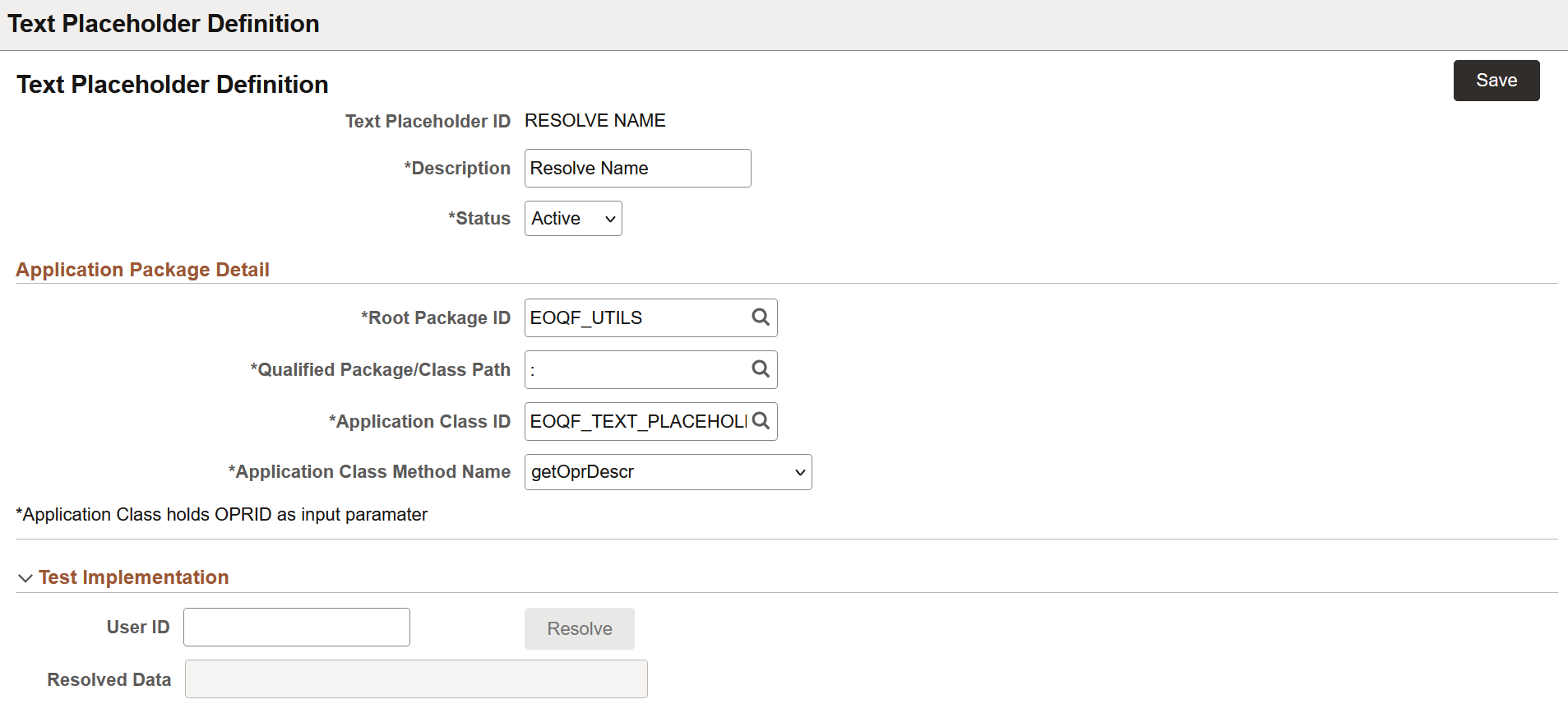
|
Field or Control |
Description |
|---|---|
|
Text Placeholder ID |
Displays the text placeholder ID you entered prior to accessing this page. |
|
Description |
Enter a meaningful description for the text placeholder. |
|
Status |
Select a status for the text placeholder. |
|
Root Package ID |
Select the root package associated with the PeopleTools Application Class that acts as the source for the text placeholder. |
|
Qualified Package/Class Path |
Select the path that defines the location of the PeopleTools Application Class that acts as the source for the text placeholder. Options listed are based on the selected Root Package. |
|
Application Class ID |
Select the PeopleTools Application Class that acts as the source for the text placeholder. |
|
Application Class Method Name |
Select the required PeopleTools Application Class Method to invoke. |
|
User ID and Resolve |
Select the ID of the user and click the Resolve button. |
|
Resolved Data |
The name of the user based on the selected ID is displayed. |
Use the Notification Template page (EOQF_NOTIF_FL) to add or edit notification message text for questionnaire events.
Navigation:
This example illustrates the Notification Template page (1 of 2).
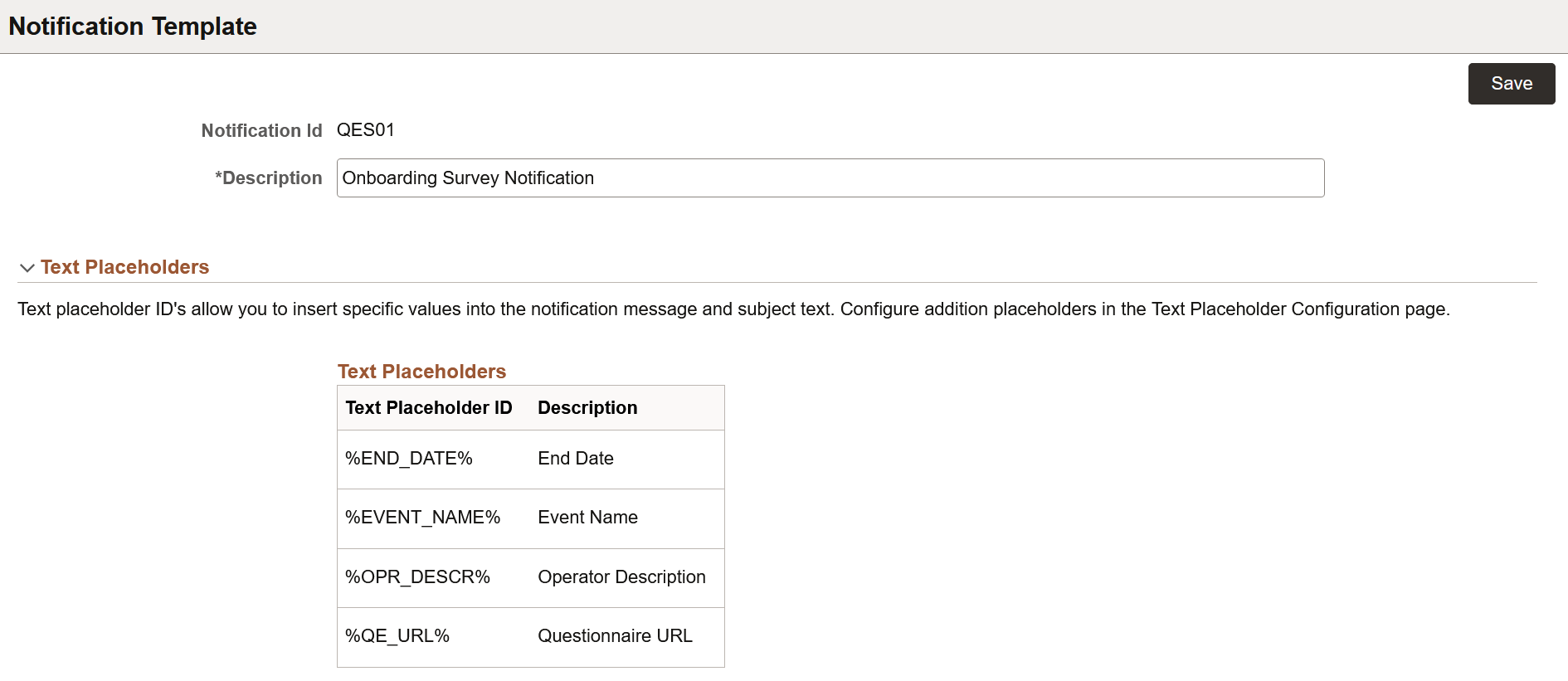
This example illustrates the Notification Template page (2 of 2).
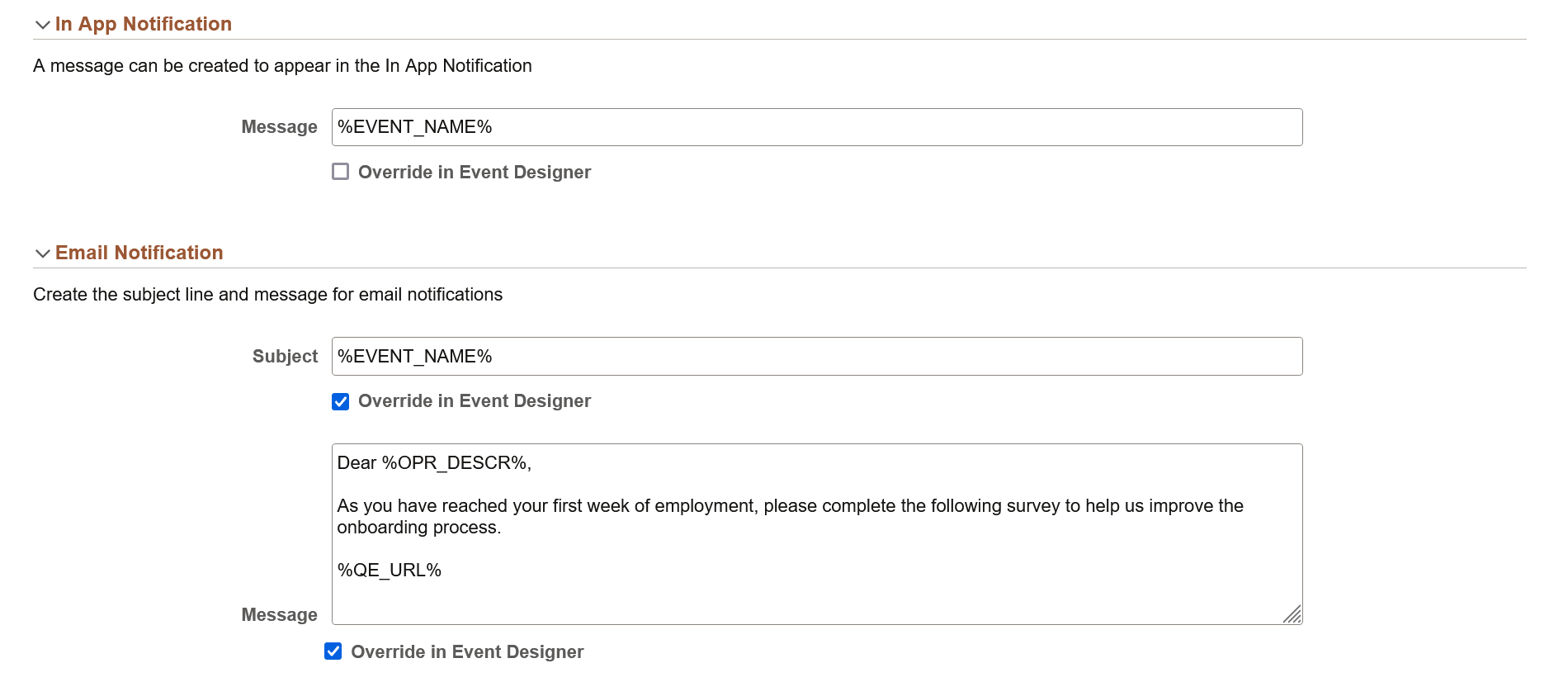
Note: Use this page to create notification content when Notification Composer is not enabled.
|
Field or Control |
Description |
|---|---|
|
Notification ID |
Displays the notification ID you entered prior to accessing this page. |
|
Description |
Enter a meaningful description. |
Text Placeholders
Use this section to review text placeholders available for the notification. Text placeholders enable you to insert variable text into the notification message and subject text. For example, you can add a text placeholder for employee name within the subject text. When the notification is sent to a group of employees, each employee has their own name in the subject.
Use the Text Placeholder Definition Page to add new text placeholders as needed.
|
Field or Control |
Description |
|---|---|
|
Text Placeholder ID |
Displays the ID of the text placeholder. |
|
Description |
Displays a description of the text placeholder. |
In App Notification
Use this section to create online notification message content.
|
Field or Control |
Description |
|---|---|
|
Message |
Enter the message text for the online notification. You can use text placeholders here. |
|
Override in Event Designer |
Select this check box if you want to make this message text editable in the Event designer. |
Email Notification
Use this section to create email notification message content.
|
Field or Control |
Description |
|---|---|
|
Subject |
Enter the subject. This text will be the subject line of the e-mail notification. You can use text placeholders here. |
|
Override in Event Designer (Subject) |
Select this check box if you want to make this subject text editable in the Event designer. |
|
Message |
Enter the message text for the e-mail notification. You can use text placeholders here. |
|
Override in Event Designer (Message) |
Select this check box if you want to make this message text editable in the Event designer. |
Use the Configurable Trigger page (EOQN_TECH_CONFIG) to configure setup data for use in creating questionnaire events that trigger questionnaires from application pages.
Navigation:
This example illustrates the fields and controls on the Configurable Trigger page (1 of 2).

This example illustrates the fields and controls on the Configurable Trigger page (2 of 2).
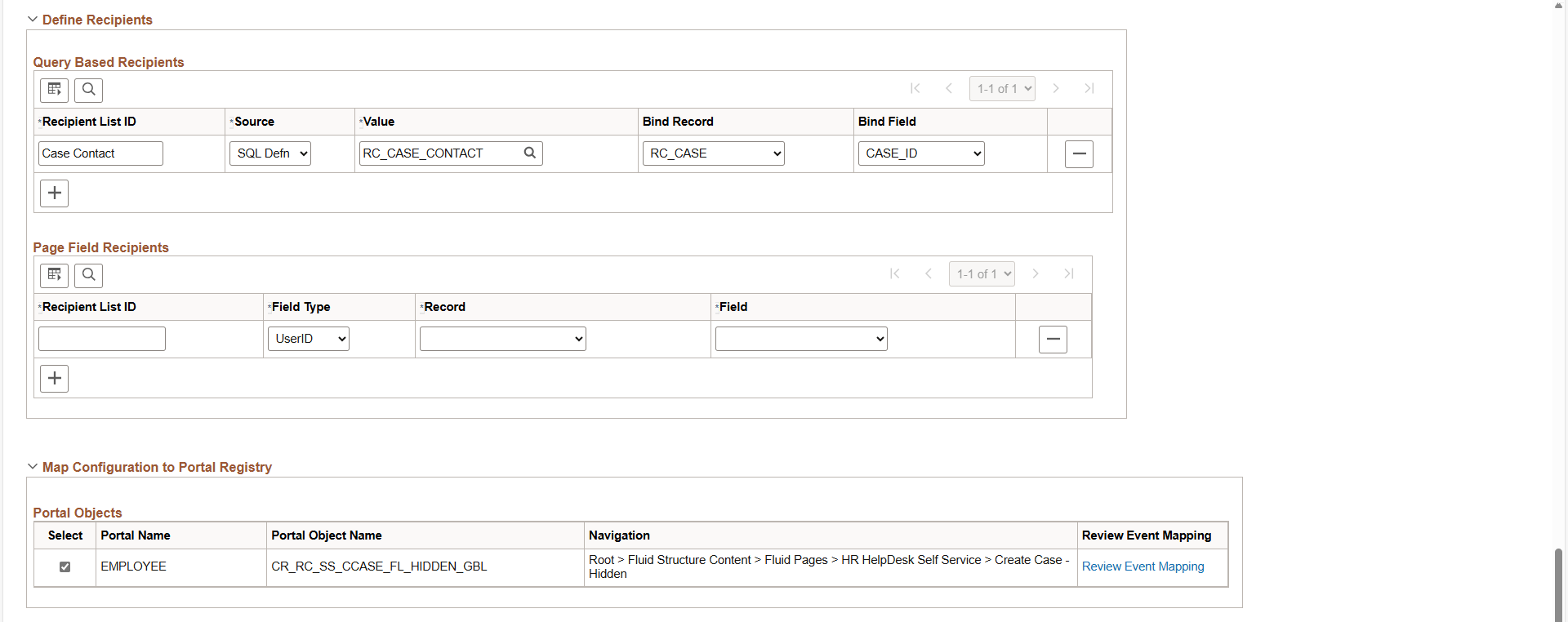
The configurable trigger setup is a technical administrator's task and is applicable to the Application Generated event type only.
|
Field or Control |
Description |
|---|---|
|
Purpose |
Displays the usage entered for the trigger configuration. |
|
Component and Market |
Displays the PeopleSoft component and market specified for the trigger configuration. |
Configure Fields
The system prepopulates all columns (except for Template Placeholder and Use in Rules fields) in this section with all record fields (level 0 fields), as well as their associated descriptions and bindings (Prompt Record, Prompt Field, Related Record, and Related Field fields) for the specified component. These fields can be used as bind parameters in notification templates and in condition definitions.
|
Field or Control |
Description |
|---|---|
|
Description |
The label of the field can be updated if needed. |
|
Template Placeholder |
Select for the field to be available for use as text placeholder in notification templates. |
|
Use in Rules |
Select for the field to be available for use in defining conditions for triggering questionnaires from application pages. |
Query Based Recipients
Use this section to define recipients of questionnaire event notifications based on query results, if preferred.
|
Field or Control |
Description |
|---|---|
|
Recipient List ID |
Enter a unique identifier for the recipient type, for example, Case Contact or Case Assigned To. |
|
Source |
Select a source for the recipient list. Available values are: Query: Select this value to use a PeopleSoft query as a source for the recipient list. SQL Definition: Select this value to use a SQL definition as a source for the recipient list. |
|
Value |
Select the applicable SQL definition or query, based on selected source. |
|
Bind Record and Bind Field |
Specify the record and field as bind data for the selected query or SQL definition, which will be resolved in real-time from the component buffer. The output returns each recipient in the form of an email address or user ID. |
Page Field Recipients
Use this section to define recipients of questionnaire event notifications based on page fields, if preferred.
|
Field or Control |
Description |
|---|---|
|
Recipient List ID |
Enter a unique identifier for the recipient type, for example, Case Contact or Case Assigned To. |
|
Field Type |
Specify if the page field will be used to return recipients in the form of email address or user ID. |
|
Record and Field |
Specify the prompt record and field from which the system resolves the email address or user ID directly from the current page context. |
Map Configuration to Portal Registry
The system prepopulates this section with all portal registries pertaining to the specified component.
|
Field or Control |
Description |
|---|---|
|
Select |
Select to map this configurable trigger setup to one or more portal registries. This mapping identifies the application pages from where questionnaires and notifications can be triggered when the pages are saved. |
|
Review Event Mapping |
Select this link to view or update the generated event mapping setup on the Review Event Mapping Page. |
Use the Review Event Mapping page (EOQN_MAP_CFG_SEC) to view or update the generated event mapping for the portal registry.
Navigation:
Select the Review Event Mapping link on the Configurable Trigger page.
This example illustrates the fields and controls on the Review Event Mapping page.
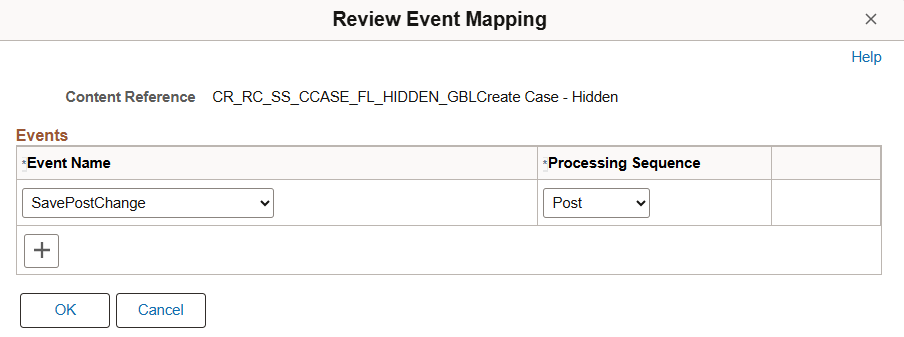
|
Field or Control |
Description |
|---|---|
|
Event Name |
Select a PeopleCode event, SavePostChange or SavePreChange. The system prepopulates a SavePostChange event mapping entry with Post processing sequence for each selected content reference. You can update the existing or add new entries if needed. |
|
Processing Sequence |
Select Post or Pre as the processing sequence. |
Use the Manage Questionnaire Events page (EOQF_EVENT_ADMN_FL) to view, update, add, delete, and copy questionnaire events.
Navigation:
This example illustrates the Manage Questionnaire Events page.

|
Field or Control |
Definition |
|---|---|
|
Filter |
Filter event results displayed in the grid. |
|
Create Event |
Select this button to access the Create Questionnaire Event Page and create a new questionnaire event. There are four pages required to create a new questionnaire event: |
|
Event ID |
Displays the questionnaire event ID. |
|
Event Name |
Displays the questionnaire event name. |
|
Event Type |
Displays the questionnaire event type. Values are: App Continuous Single |
|
Status |
Displays the questionnaire event status. Values are:
Deactivate or activate a questionnaire event using the Process Questionnaire Event Page. |
|
Start Date |
The date on which the questionnaire event link is active. |
|
End Date |
The date on which the questionnaire event link expires. |
|
Statistics |
Select to access the Statistics Page and view data related to the questionnaire, such as response status and processing history. |
|
Update Event |
Select to access the Define Event Configuration Page and view or edit the questionnaire event. |
|
Delete Event |
Select to delete the questionnaire event. |
|
Clone Event |
Select access the Clone Questionnaire Event Page and copy the questionnaire event. |
Use the Create Questionnaire Event page (EOQF_EVENT_ADD_SCF) to create a new questionnaire event and define basic event information.
Navigation:
Select the Create Event button on the Manage Questionnaire Events page.
This example illustrates the Create Questionnaire Event page.
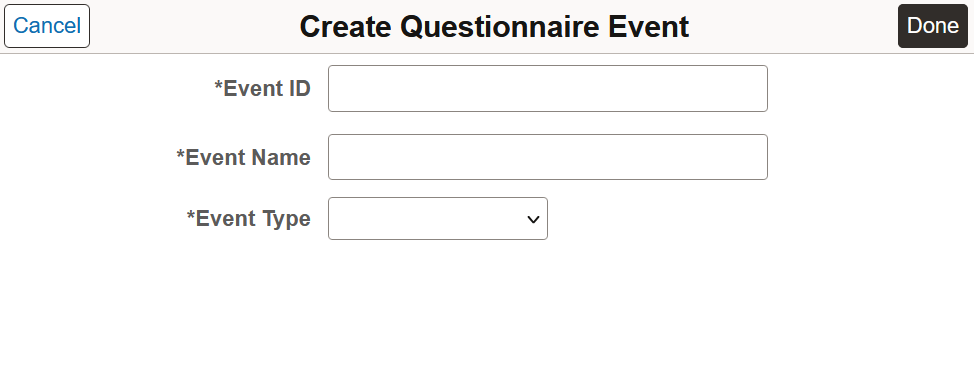
|
Field or Control |
Definition |
|---|---|
|
Event Name |
Enter a name for the questionnaire event. |
|
Event ID |
Enter an event ID for the questionnaire event. |
|
Event Type |
Select the event type. Values are: Application Generated: Select this value if the questionnaire event is launched from an application page. Continuous: Select this value if the questionnaire event is an ongoing activity. Single: Select this value if the questionnaire event is a one-time activity. |
|
Purpose, Component, and Market |
Specify the purpose of the configurable trigger definition to use for the questionnaire event. The system populates the associated component and market automatically. These fields appear if the selected event type is Application Generated. Configurable triggers are defined on the Configurable Trigger Page. |
|
Done |
Select this button to access the Create Questionnaire Event activity guide and the Define Event Configuration Page. |
Use the Define Event Configuration page (EOQF_EVENT_CNFG_FL) to specify questionnaire event details and recipients.
Navigation:
Select the Done button on the Create Questionnaire Event page.
Select the Update Event button of a questionnaire event row on the Manage Questionnaire Events page.
This example illustrates the Define Event Configuration page for Single and Continuous event types.
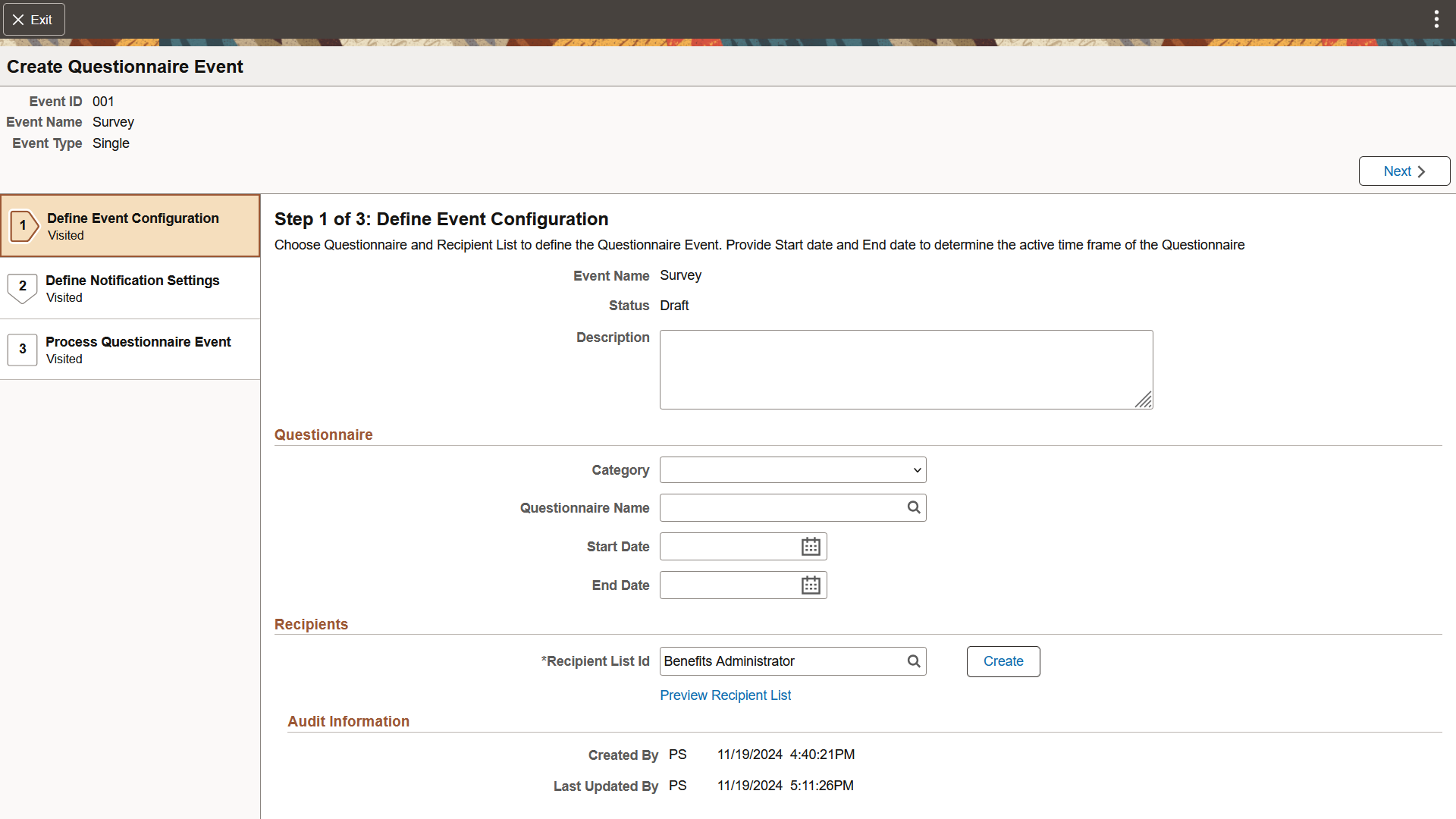
This example illustrates the Define Event Configuration page for the For Application event type.
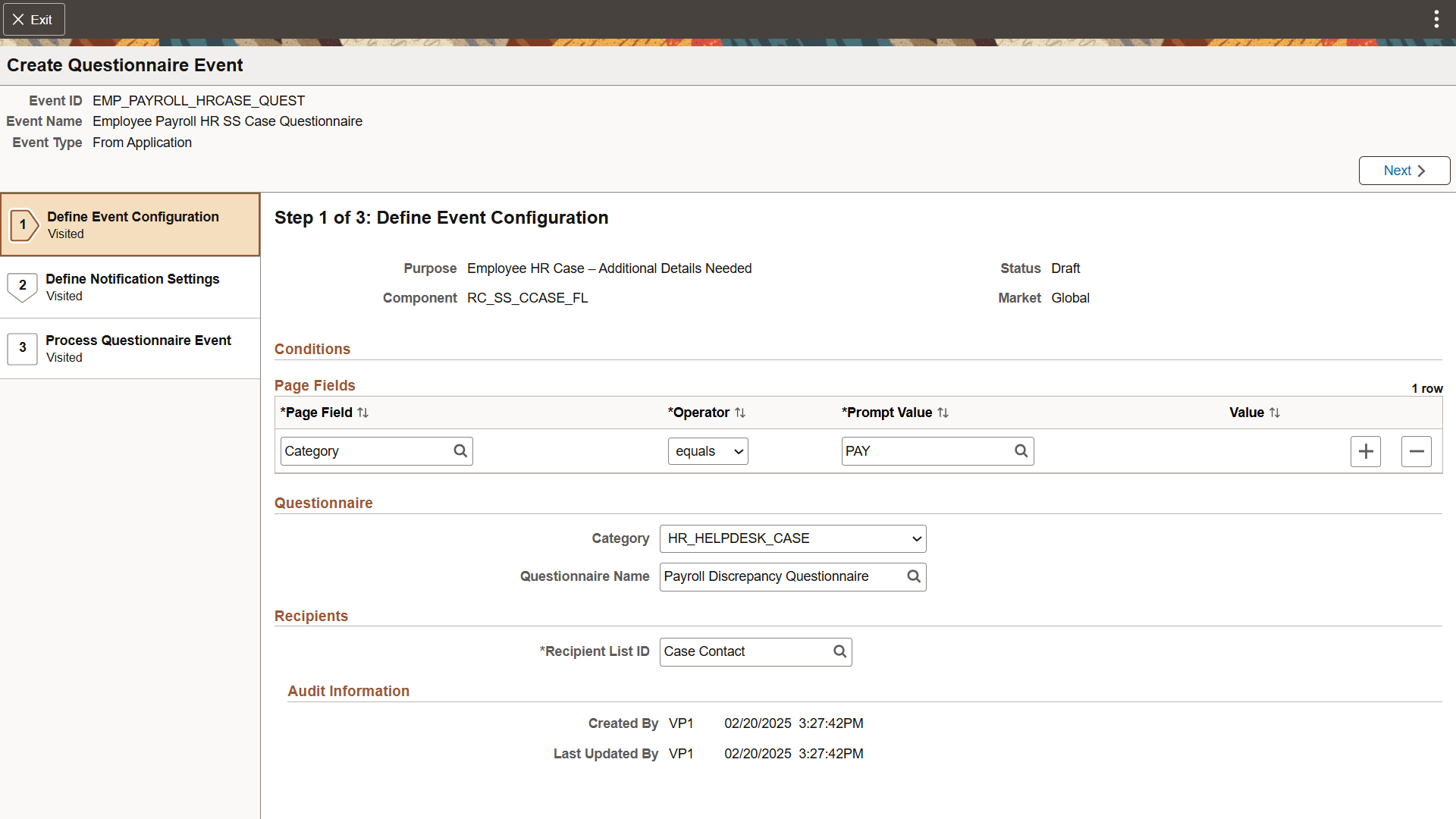
Click the Next button to proceed to the next step in the create questionnaire event guided process. You can click any of the steps on the left-hand pane to access that particular step in the guided process if you had already visited that step.
|
Field or Control |
Description |
|---|---|
|
Event Name |
Displays the event name, which you entered on the Create Questionnaire Event page. |
|
Status |
Displays the event status, which you entered on the Create Questionnaire Event page. |
|
Description |
Enter a meaningful description that explains the questionnaire event. |
Conditions
This section is applicable to the Application Generated event type only.
Use this section to define the conditions that trigger the questionnaire of this event from an application page when the page is saved and all conditions are met.
|
Field or Control |
Description |
|---|---|
|
Add Condition |
Select to enter conditions that trigger the questionnaire of this event using the page fields that appear. |
|
Page Field |
Specify the field used to define the triggering condition. Fields that have the Use in Rules field selected in the associated configurable trigger setup are available for selection. |
|
Operator |
Available operator values are contains, equals, and is null. |
|
Prompt Value |
Specify the field value for the condition. Prompt values come from the setup of the selected page field in the associated configurable trigger setup. |
Questionnaire
|
Field or Control |
Description |
|---|---|
|
Category |
Select the questionnaire category to which this questionnaire event belongs. For example, values for HCM are:
Values for FSCM are COMMON and PROJECTS. The available category for CRM is COMMON. Questionnaire categories are defined in the Questionnaire Category Page. |
|
Questionnaire Name |
Select the questionnaire for the event. Available field values are based on the questionnaire category you select. Questionnaires are defined in the Define Questionnaire Page. |
|
Start Date and End Date |
Define the period in which the questionnaire is available to recipients using these date fields. These fields are not applicable to the Application Generated event type. |
|
Expires after (In days) |
Specify the number of days in which the instances of the questionnaire expire after they are launched. This field is applicable to the Continuous event type only. |
Recipients
|
Field or Control |
Description |
|---|---|
|
Recipient List ID |
Select a recipient list for the questionnaire event, based on your target audience. (If Notification Composer is enabled) Available recipient lists come from user lists that are defined on the Define User List Page for Notification Composer. (If Notification Composer is not enabled) Available recipient lists are defined on the Recipient List Page. (For Application Generated event type) Available recipient lists come from the associated configurable trigger setup. |
|
Create |
Select this button to access the Recipient List Page and create a new recipient list. |
|
Preview Recipient List |
Select this link to view users associated with the recipient list. You can also view email address for each user. |
Audit Information
This section displays the user ID and time-stamp associated with the creation and update of this questionnaire event.
Use the Define Notification Settings page (EOQF_EVENT_NOTF_FL) to associate one or more notifications with the questionnaire event.
Navigation:
Select the Next button on the Define Event Configuration page.
Select Define Notification Settings on the left panel of the Create Questionnaire Event component.
This example illustrates the Define Notification Settings page.

Select a notification row to view notification details in the Notification Designer Page.
|
Field or Control |
Description |
|---|---|
|
Add Notification |
Select this button to access the Notification Designer Page and create a new notification for the questionnaire event. |
|
Notification Type |
Displays the notification type associated with the notification. |
|
Notification Description |
Displays the description associated with the notification. |
|
Start Date |
Displays the date on which the questionnaire event is available to recipients. Note: This field appears only when you select Post Event, Questionnaire Event or Pre Event as the notification type. For Questionnaire Event, the date defaults from the date given in the Define Event Configuration page. |
|
Recurrence |
Displays recurring notification information. This field only appears for the Follow Up Event notification type. |
Use the Notification Designer page (EOQF_NOTF_DSGN_SCF) to create a notification for the questionnaire event. This page is only accessible within the Create Questionnaire Event activity guide.
Navigation:
Select the Add Notification button on the Define Notification Settings page.
This example illustrates the Notification Designer page (1 of 2).
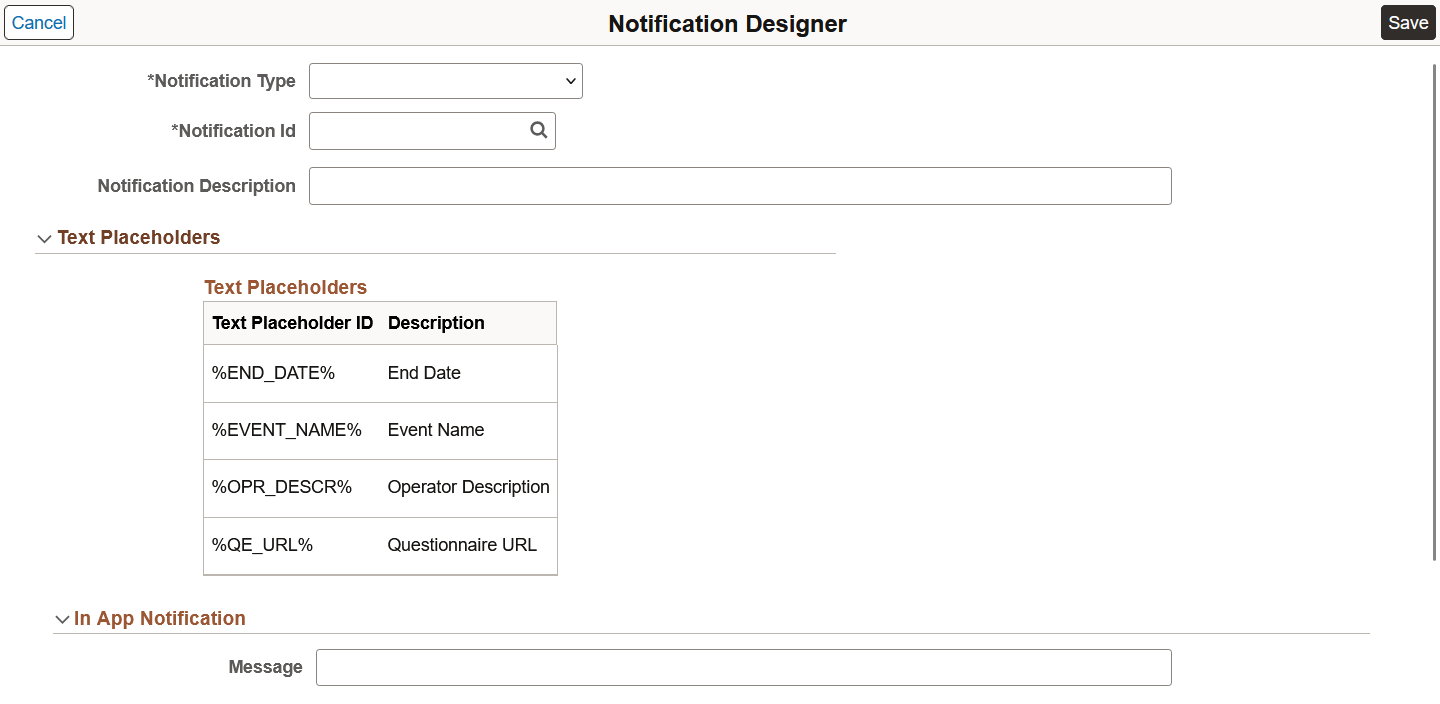
This example illustrates the Notification Designer page (2 of 2).
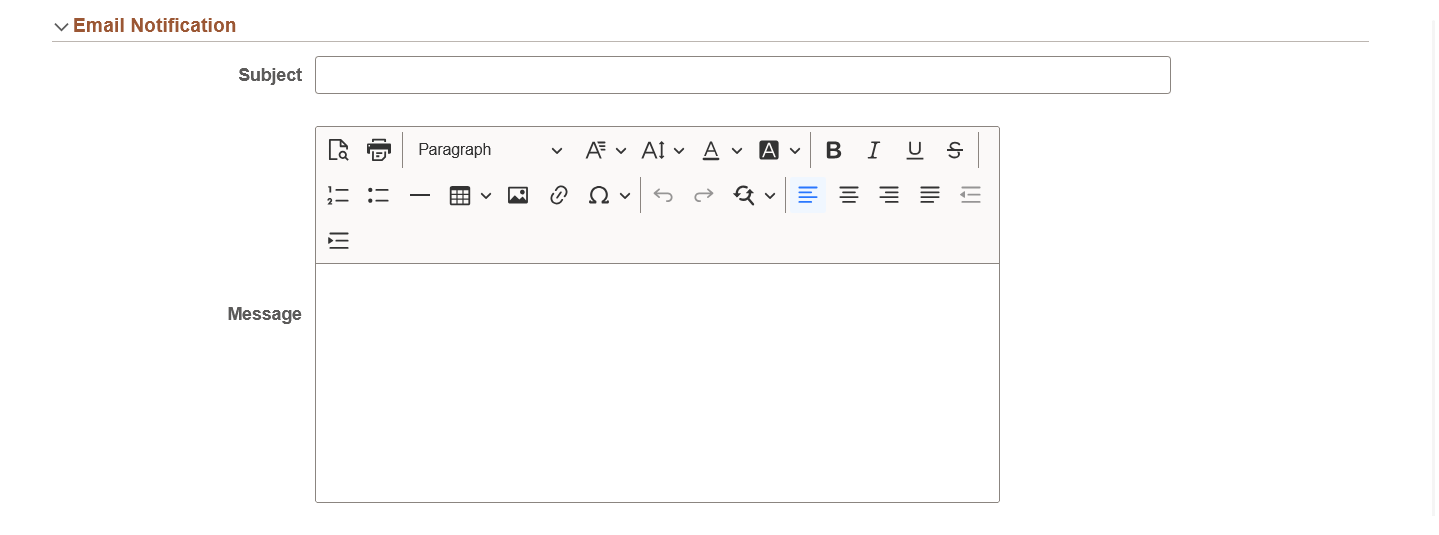
|
Field or Control |
Description |
|---|---|
|
Notification Type |
Specify the type of event associated with this notification. Available values are:
|
|
Notification Id |
Specify the ID of the notification template to use for this notification. If Notification Composer is enabled, select from the notifications that are defined in Notification Composer. Only Questionnaire Framework notifications are available for selection. See Also Compose Notification - Search Page. If Notification Composer is not enabled, select from the notifications that are defined on the Notification Template Page. |
|
Recurrence |
Specify whether the notification is recurring. Available values are:
Note: This field only appears for the Follow Up Event notification type. |
Text Placeholders
Use this section to review text placeholders available for the notification. Text placeholders enable you to insert variable text into the notification message and subject text. For example, you can copy and paste a text placeholder for employee name within the subject text. When the notification is sent to a group of employees, each employee has their own name in the subject.
There are two ways text placeholders can be created:
Define them on the Text Placeholder Definition Page. Or,
(For the Application Generated event type only) Select the Template Placeholder option for fields on the Configurable Trigger Page.
|
Field or Control |
Description |
|---|---|
|
Text Placeholder ID |
Displays the ID of the text placeholder. |
|
Description |
Displays the description of the text placeholder. |
In App Notification
Use this section to create online notification message content.
|
Field or Control |
Description |
|---|---|
|
Message |
Enter the message text for the push notification. Text placeholders can be used. |
Email Notification
Use this section to create email notification message content.
|
Field or Control |
Description |
|---|---|
|
Subject |
Enter the subject. This text will be the subject line of the e- mail notification. Text placeholders can be used. |
|
Message |
Enter the message text for the e-mail notification. Text placeholders can be used. |
Use the Process Questionnaire Event page (EOQF_EVENT_PRCS_FL) to activate or deactivate a Questionnaire Event.
Navigation:
Select the Next button on the Define Notification Settings page.
Select Process Questionnaire Event on the left panel of the Create Questionnaire Event component.
This example illustrates the Process Questionnaire Event page before activation.

This example illustrates the Process Questionnaire Event page after activation.
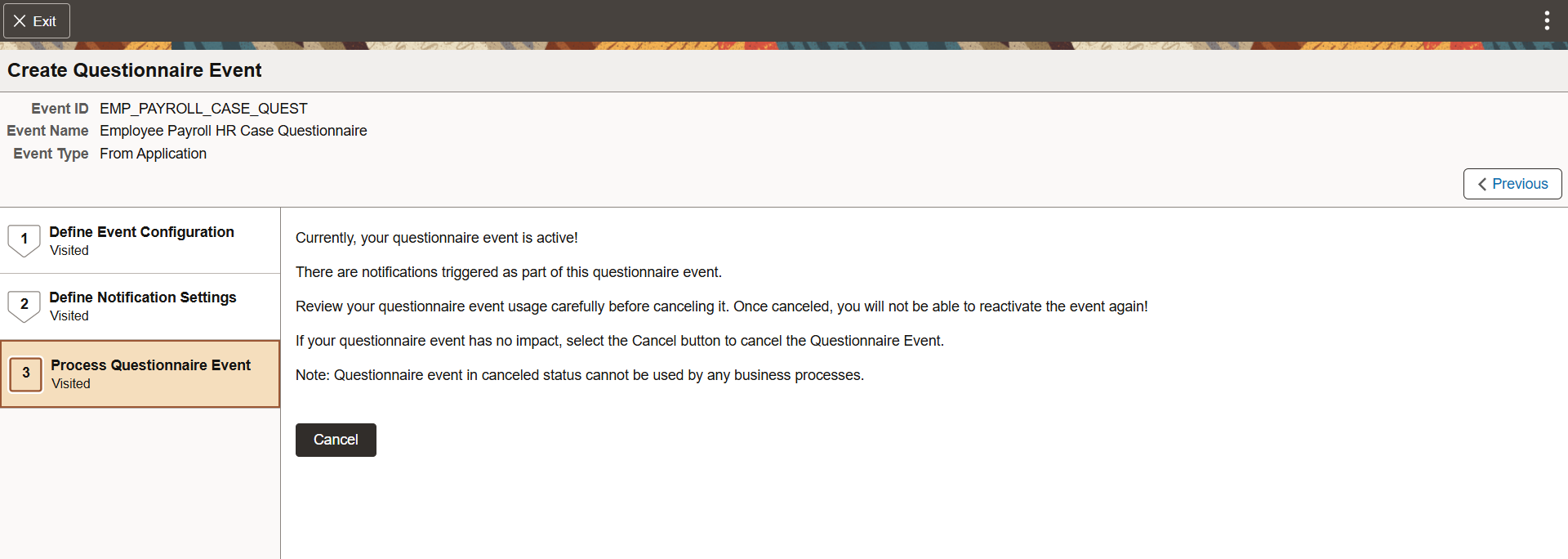
Use the Statistics page (EOQF_EVNT_STAT_SCF) to view data related to the questionnaire event, such as response status and processing history.
Navigation:
Select the Statistics icon of a questionnaire event row on the Manage Questionnaire Events page.
This example illustrates the Statistics page.
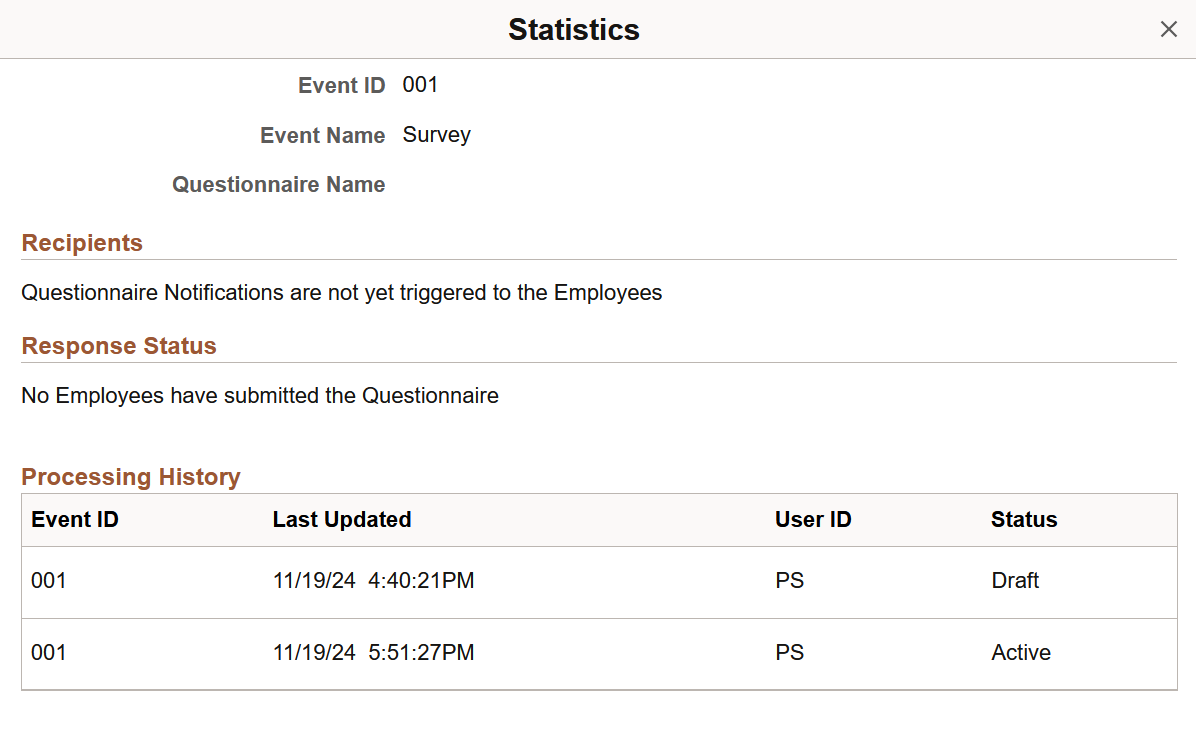
Use the Clone Questionnaire Event page (EOQF_CLONE_EVN_SCF) to copy an existing questionnaire event.
Navigation:
Select the Clone Event icon of a questionnaire event row on the Manage Questionnaire Events page.
This example illustrates the Clone Questionnaire Event page.

Use the Adhoc Notification Execution page (EOQF_EVENT_RUNCNTL) to run an adhoc notification process for a specific questionnaire event.
Navigation:
This example illustrates the Run control page for Adhoc Notification.
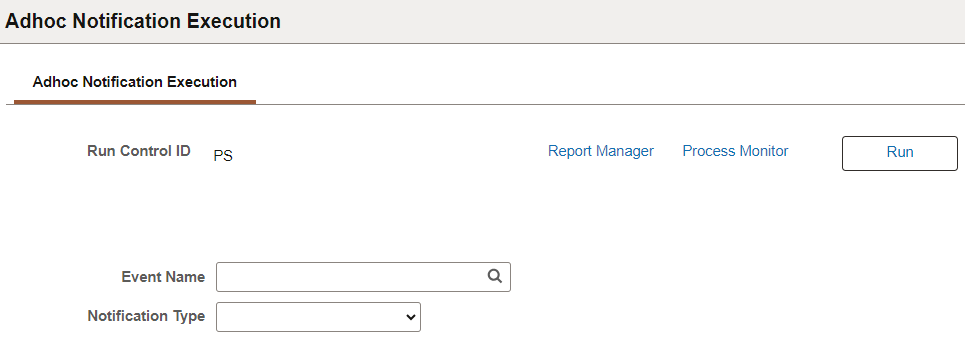
|
Field or Control |
Description |
|---|---|
|
Event Name |
Select the questionnaire event for which you need to initiate the Adhoc notification process (EOQF_RUNEVNT). |
|
Notification Type |
Select either Adhoc or Questionnaire Event as the notification type. |